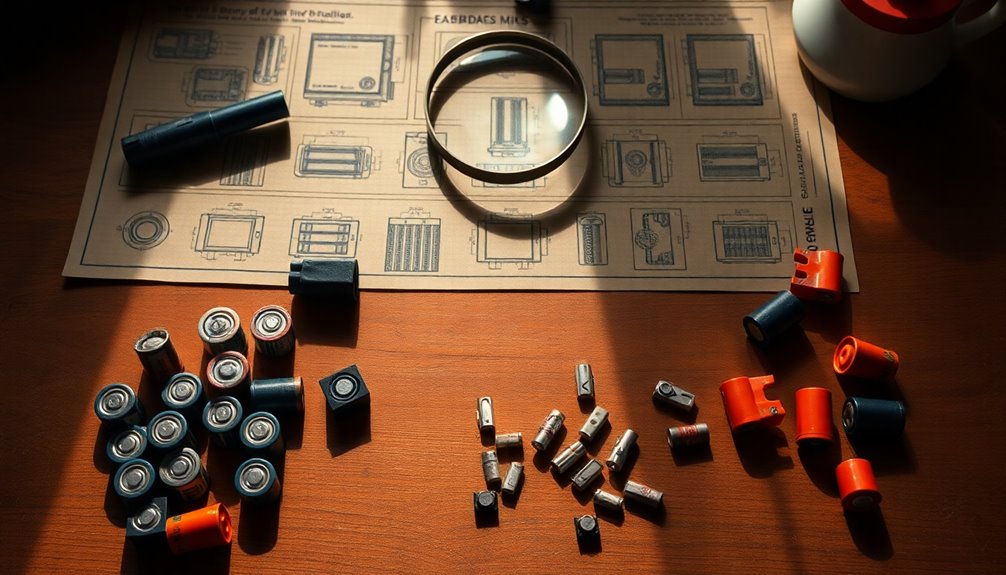Clay is incredibly versatile and serves multiple important purposes. You might know it best from ceramics, where it's used to create everything from pottery to fine china. But that's not all! Clay also boosts battery performance, makes plaster stronger and easier to work with, and acts as a binder in chalk for that smooth texture you appreciate. Each use leverages its unique properties, showcasing how essential clay is across industries. If you're curious about how these applications compare or want to explore other innovative uses, there's much more to discover about this remarkable material.
Key Takeaways
- Clay is essential in ceramics, utilized for making pottery, tableware, and artistic creations with various types like earthenware and porcelain.
- In battery production, clay enhances conductivity and performance, contributing to eco-friendly energy solutions.
- Clay is a key ingredient in plaster, improving workability, strength, and adhesion properties in construction applications.
- As a binder in chalk, clay maintains structural integrity while providing a smooth texture for writing and drawing.
- Clay's versatility allows it to serve multiple industries, debunking the misconception that it is only used for pottery.
Understanding Clay Properties
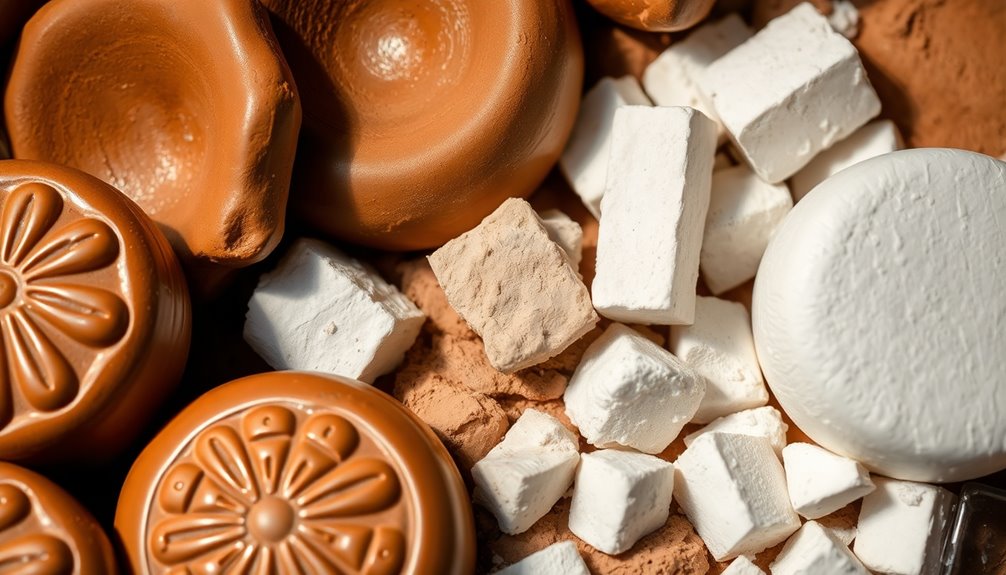
Clay, a fascinating natural material, offers a range of properties that make it incredibly versatile.
You'll find that its fine-grained composition allows it to be molded easily, retaining its shape while you create intricate designs in ceramics.
When fired at high temperatures, clay undergoes sintering, transforming into a durable, hard material perfect for pottery.
Its high heat resistance means it's also suitable for construction materials like bricks and tiles.
Different types of clay, such as earthenware and porcelain, have unique characteristics that cater to specific uses for clay in various industries.
Whether you're crafting pottery or working on construction projects, understanding these properties will help you leverage clay's potential effectively.
Historical Role of Ceramics

You mightn't realize it, but ancient pottery techniques reveal a lot about the cultures that created them.
These ceramics served as essential cultural artifacts, showcasing the artistry and daily lives of past societies.
Understanding their significance can deepen your appreciation for the role ceramics played in shaping human history.
Ancient Pottery Techniques
Throughout history, the techniques used in ancient pottery have played an essential role in shaping human culture and daily life.
You'll find that ancient pottery techniques, dating back to around 29,000 BC in East Asia, reveal our long-standing connection to ceramics. Early methods, like coiling and pinching, paved the way for innovations such as the potter's wheel in Mesopotamia around 3500 BC.
Different civilizations, like the Greeks and Chinese, created unique pottery styles and glazing techniques that reflected their cultural values and artistic expression.
Cultural Artifacts Significance
Ceramics serve as essential cultural artifacts that reveal much about the societies that created them. For thousands of years, these items have been integral to cultural heritage, showcasing the evolution of human craftsmanship.
Historical pottery styles, like those from ancient Greece and China, provide valuable insights into social, economic, and technological advancements. The shift from utilitarian pottery to decorative ceramics reflects changing cultural values and artistic expressions.
Archaeological discoveries of ceramics often illuminate trade routes, daily life, and rituals, helping us understand ancient civilizations.
Even today, ceramics bridge the gap between traditional craftsmanship and modern design, continuing to play a crucial role in various industries while preserving the rich legacy of our past. Additionally, the use of natural materials in ceramics highlights the connection between artistry and sustainability in contemporary practices.
Applications of Clay in Ceramics
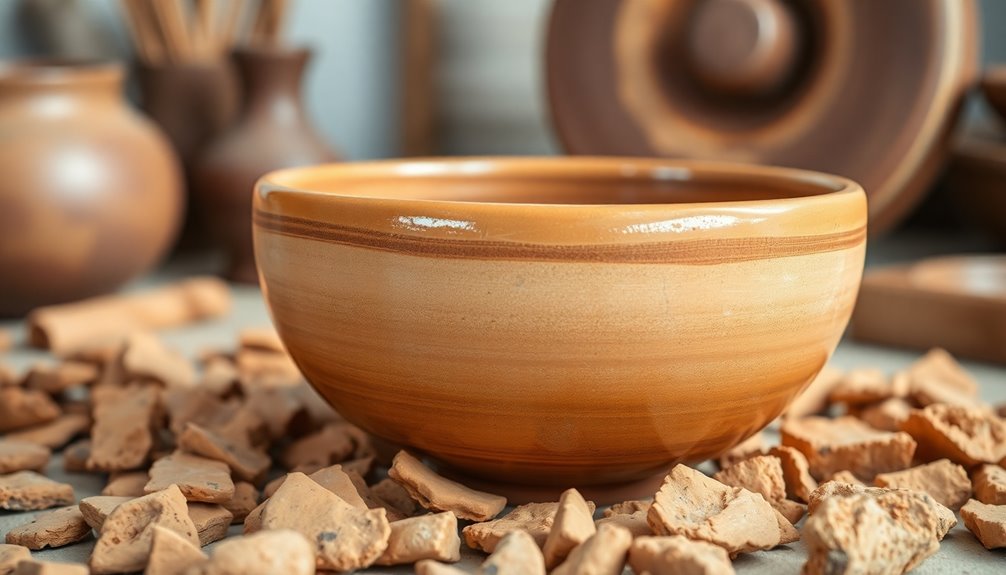
When you explore the applications of clay in ceramics, you'll find a variety of clay types, like earthenware and porcelain, each with its own unique characteristics.
This versatility allows for both artistic creations and functional items, such as pottery and tableware.
Understanding these uses can enhance your appreciation of the craftsmanship behind ceramic products.
Types of Clay Used
While exploring the diverse applications of clay in ceramics, you'll find that different types serve unique purposes based on their properties and firing temperatures. For instance, earthenware is great for pottery, while stoneware is perfect for durable items. Porcelain, known for its strength and translucency, is often used for fine china. Here's a quick overview of some common types:
| Type of Clay | Characteristics | Typical Use |
|---|---|---|
| Earthenware | Low firing temperature | Pottery and tiles |
| Stoneware | High firing temperature | Dinnerware and cookware |
| Porcelain | High purity and translucency | Fine china and art |
Understanding these types helps you appreciate the essential role clay plays in the ceramics industry. Additionally, the choice of materials like oak and maple can significantly influence the design and functionality of ceramic pieces.
Artistic Applications in Ceramics
Clay opens up a world of artistic possibilities, allowing you to create everything from functional pottery to stunning decorative pieces.
In ceramics, the versatility of clay lets you explore various artistic applications. Different types of clay, like earthenware, stoneware, and porcelain, each lend unique textures and firing characteristics to your work. Its malleability enables you to shape intricate designs, bringing your creative vision to life.
Once fired at high temperatures, the clay transforms into durable, often water-resistant pieces. You can further enhance your artwork with various glazing techniques, adding vibrant colors and textures that elevate the aesthetic appeal. Additionally, experimenting with different types of wax can influence your choice of materials if you decide to incorporate candle-making elements into your artistic projects.
Embrace the artistic journey with clay, and let your imagination guide you in the world of ceramics.
Functional Pottery and Tableware
Creating functional pottery and tableware not only enhances your dining experience but also adds a personal touch to your kitchen.
Clay, the primary ingredient in ceramics, allows you to craft beautiful bowls, plates, and mugs that are both practical and visually appealing. You'll find that different types of clay, like stoneware and earthenware, offer unique properties tailored for various tableware applications.
Fired clay is particularly advantageous, showcasing excellent heat resistance, making it perfect for oven-safe cookware and baking dishes. Plus, using clay in your functional pottery contributes to sustainable practices since many ceramic products are crafted from natural materials that can be recycled or reused. Additionally, incorporating natural materials into your designs can enhance both aesthetics and functionality.
Elevate your kitchen with unique, handmade tableware that reflects your style.
Alternative Uses of Clay

Although often associated with pottery and sculptures, clay's versatility extends far beyond traditional artistic uses.
You might be surprised to learn how clay plays a significant role in various industries:
- Batteries: Clay enhances conductivity and performance in specific battery types.
- Plaster: As an additive, clay improves workability and strength, making it ideal for construction.
- Chalk: Clay acts as a binder, maintaining structural integrity while providing a smooth texture.
These alternative uses highlight clay's adaptability and importance beyond ceramics.
Whether it's in drilling fluids or in construction, clay is an essential material that contributes to efficiency and quality across different applications.
Embracing its versatility can lead to innovative solutions in diverse fields.
Clay in Battery Production
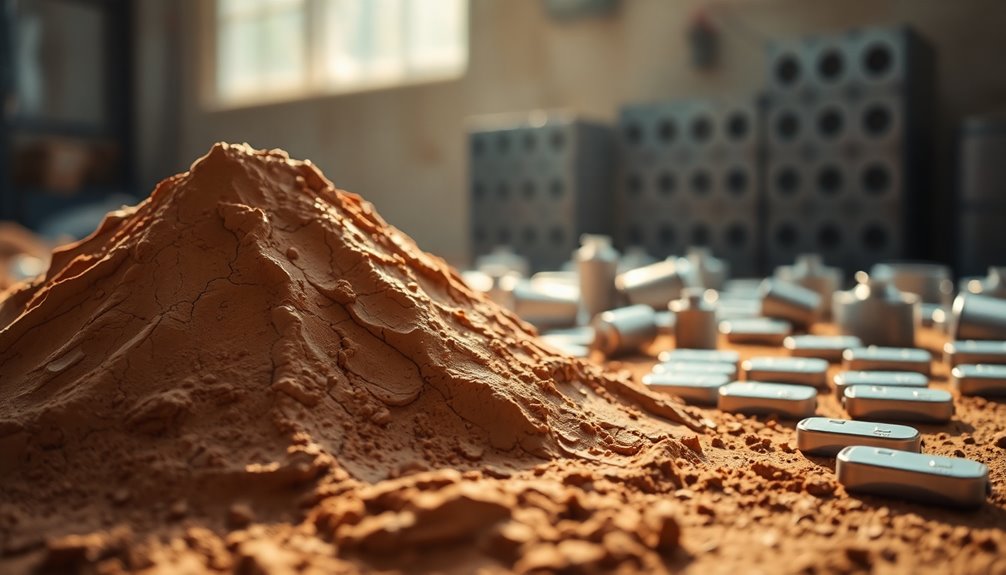
In the world of energy storage, clay plays an essential role in the production of lithium-ion batteries. You mightn't realize it, but clay enhances conductivity and overall performance in these ceramics batteries.
Incorporating clay materials improves the mechanical properties and thermal stability of battery electrodes, which means longer-lasting and more efficient batteries. Ball clay, with its remarkable plasticity, is often added to guarantee peak shaping during manufacturing.
Plus, using clay helps create more sustainable and eco-friendly energy solutions, as research indicates that clay-based materials can replace harmful components commonly found in battery production.
Clay's Role in Plaster
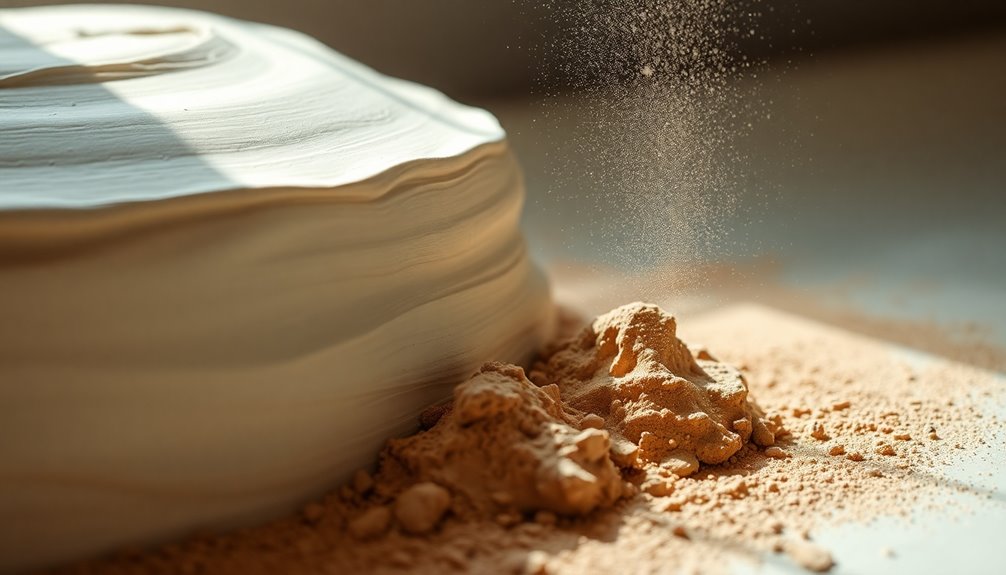
When you mix clay into plaster, you enhance its workability and strength while reducing the chances of shrinkage and cracking.
This natural additive not only improves adhesion but also contributes to a more eco-friendly construction process.
Understanding clay's role can help you appreciate its significance in various plaster applications.
Clay Properties in Plaster
Clay plays an essential role in enhancing plaster's performance, making it an important additive in construction. By incorporating clay, you can greatly improve several key properties of plaster:
- Workability: Clay's plasticity allows for a smoother application, ensuring a refined finish.
- Durability: When fired, clay enhances durability and resistance to cracking, which is critical for long-lasting plaster.
- Moisture Regulation: Clay helps manage moisture levels, preventing quick drying and minimizing shrinkage or fissures.
These clay properties not only enhance the functional aspects of plaster but also contribute to its aesthetic appeal, making it ideal for decorative finishes often seen in ceramics and artistic applications.
Applications in Construction Industry
While many materials contribute to construction, few have the versatility of clay, especially in plaster applications.
Clay is a key ingredient in plaster formulations, enhancing workability and adhesion. When you mix clay with water, it provides plasticity, allowing you to shape and apply plaster easily on various surfaces. This addition not only improves durability but also increases resistance to cracking, making it suitable for both interior and exterior finishes.
Certain clays, like ball clay, help retain moisture during curing, ensuring a strong finish. Plus, clay-based plasters are eco-friendly, utilizing natural materials that support sustainable construction practices.
Chalk Production With Clay

Chalk production relies heavily on the unique properties of clay, which serves as an essential binder that enhances the texture and consistency of the final product.
The plasticity of clay allows manufacturers to easily shape and mold chalk into various forms.
Here are some key benefits of using clay in chalk production:
- Improved Texture: Clay contributes to a smooth finish, making chalk easier to write with on surfaces.
- Shaping Capability: Ball clay, known for its high plasticity, retains shape well when dried, enabling uniform chalk sticks.
- Eco-Friendly: Clay-based chalk is made from natural materials, reducing reliance on synthetic components.
Comparison of Clay Uses
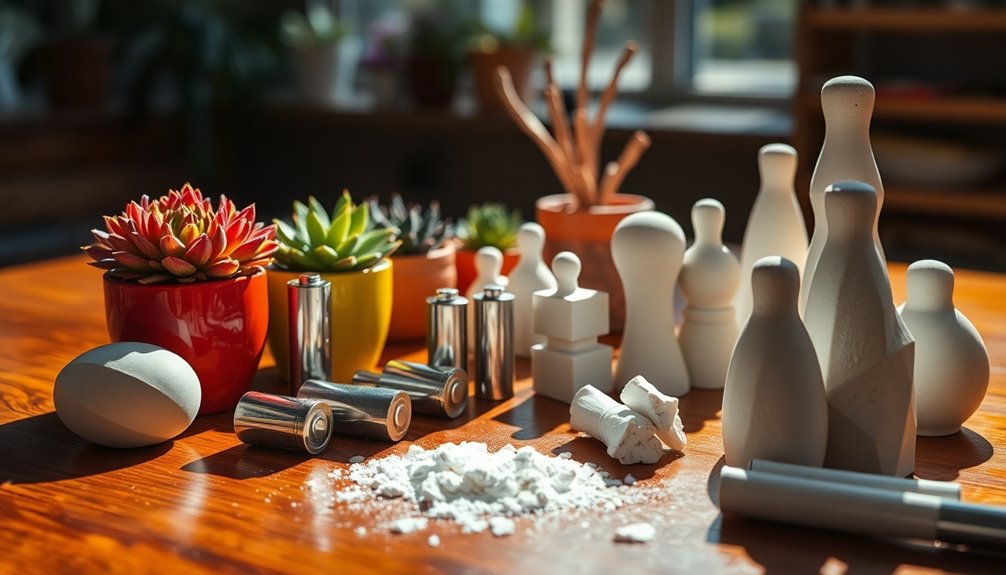
Several industries showcase the remarkable versatility of clay, each leveraging its unique properties for different applications.
In ceramics, clay is essential for creating pottery, tiles, and artistic pieces through careful shaping and firing.
Meanwhile, in the battery sector, clay enhances performance by acting as a conductive component in certain battery types.
When it comes to plaster, adding clay improves workability and durability, making it ideal for construction and medical uses.
Additionally, clay serves as a binder in chalk production, ensuring the texture and consistency of the final product.
This comparison highlights how clay's diverse applications extend far beyond traditional ceramic uses, emphasizing its importance across various fields.
Benefits of Clay Materials
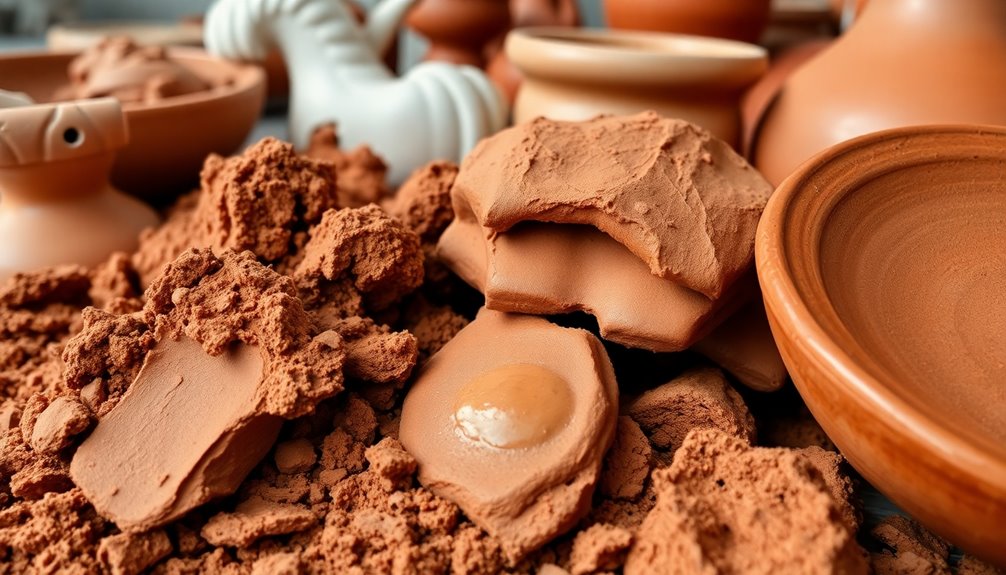
Clay materials offer a multitude of benefits that enhance their appeal across various applications. Their versatility makes them indispensable in several industries.
Here are three key advantages:
- Durability in Ceramics: Clay's inherent strength contributes to the longevity and aesthetic appeal of pottery and functional ware.
- Enhanced Conductivity in Batteries: Clay plays a crucial role in certain battery designs, improving conductivity and overall performance in energy storage solutions.
- Improved Properties in Plaster: When added to plaster, clay enhances adhesion and durability, making it a preferred choice in construction.
With its plasticity, clay can be easily molded and shaped, allowing for creativity and innovation in both artistic endeavors and industrial uses. This adaptability truly sets clay apart as a valuable material, much like the importance of regular maintenance for ensuring safety in wood stove operation.
Common Misconceptions About Clay
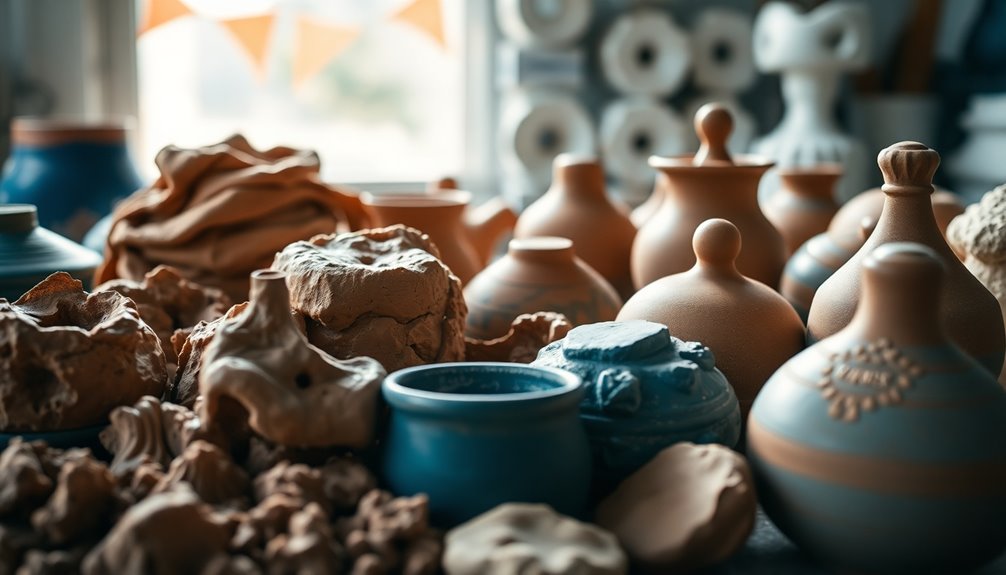
While many people associate clay primarily with pottery, it actually boasts a diverse range of applications that extend far beyond the artistic domain. Here are some common misconceptions about clay:
| Misconception | Reality | Importance |
|---|---|---|
| Clay is only for pottery | It's used in ceramics, batteries, and more | Essential for various industries |
| All clay types are the same | Different types exist with unique properties | Critical for specific uses |
| Clay can't be recycled | Many types can be reclaimed and reused | Eco-friendly material |
Additionally, clay serves an industrial role, enhancing plaster properties and acting as a binder in chalk production. Plus, alternative methods like air-drying allow for ceramics without firing.
Frequently Asked Questions
Which Is a Used for Clay?
When you think about clay, it's fascinating how versatile it is. You can shape it for pottery and sculptures, or use it in batteries to boost conductivity.
If you're working on construction, you might mix clay into plaster for better durability. Plus, it's crucial in making chalk, giving it that perfect texture.
Which Is a Use for Clay Brainly?
You might think clay's only good for making pots, but it's got way more uses! In fact, clay's essential in various industries.
You see it in ceramics, where it's shaped and fired into beautiful items. It also enhances battery performance and improves plaster's workability.
Plus, clay acts as a binder in chalk, giving it the right texture. So, clay's versatility makes it a valuable material in so many applications!
Conclusion
In the grand tapestry of materials, clay weaves a story rich with versatility. From shaping timeless ceramics to powering modern batteries, its uses are as diverse as the colors of a sunset. You've seen how it molds our world, from sturdy plaster to chalk's delicate touch. Embrace clay's many roles, for it's not just earth beneath our feet, but a fundamental thread in the fabric of innovation. So, let's celebrate clay, a true marvel of nature's artistry!






